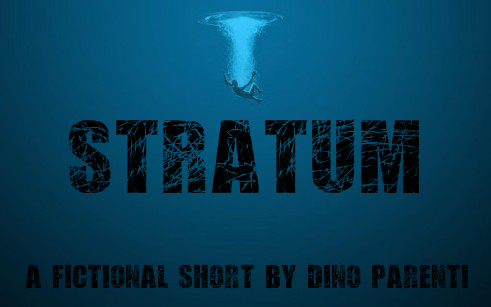Stratum by Dino Parenti
The following story was originally published in Cease, Cows in December of 2013. Click here to see the original posting.
If you missed it, don’t fret. From up here, the raised thumb of the Yucatan Peninsula passes beneath me sixteen times a day. Whenever possible, I finger-trace the submerged impact depression of the Chicxulub Crater through a portal. Stroke the big rock that ended the Cretaceous Era. When you can touch something that’s never been touched, it should be the final act of your life.
Twenty years ago, as the tour-guide prattled on about diving-depth limits, this was on my mind. See, I hadn’t flown a thousand miles to Chicxulub to pearl-dive. Nor did I end up in outer space last week just to drop a few steel sepulchers into geo-synchronous orbit. But to straddle time, one requires staging.
—
One thing I did glom from that tour-guide in Mexico: human physiological limit with scuba gear is around two-hundred feet.
A five-millimeter layer of Neoprene, a quarter-inch of tank steel, and assorted plies of rubber and plastic keep you ticking. Beyond that, without specific air mixtures and a slow, careful ascent, you’re feeding tube worms.
Up here in the derelict International Space Station, it’s no different, really. A few centimeters of Kevlar-reinforced insulation swaddling mere millimeters of aluminum. That’s it. All that stands between me and the vacuum.
Between me and Perses, the other big rock on the way.
—
How I got here is, after the navy, I fell into designing high-end safes for wealthy VIPs. I innovated a self-locking spherical model composed of titanium, got wealthy, then got bored.
After Perses appeared, so did motivation. One day I cladded a sphere with a layer of tantalum to shield against ionizing radiation, and the prototype for the Remembrance Sphere was born.
When I was offered a small fortune to crank out a batch in short order, I deferred it. I had no idea how to monetize a thing that I saw as achievable by any number of other obsessives.
—
The Chicxulub asteroid I yearned to feel has no name other than for the region it hit. When asteroid 2072-ND13 was discovered eighteen months ago, it was designated Perses, after the Greek titan of destruction. An amateur stargazer in Idaho with a backyard telescope spotted a fourteen-kilometer-wide rock that none of our underfunded agencies could with their vastly larger arrays.
Once the number-crunching verified the worst-case-scenario, it was decided that cultural posterity should reside separately from where the only viable shelters were being covertly built under the Patagonian Andes, ironically not far from the ground-zero camp from which an ancient superbug killed millions not two generations back.
The funding source for these shelters remains vague, diffuse, unhampered by red tape. Then again, decision-making and forethought were never our species’ greatest strengths.
—
It’s been said that an opened Remembrance Sphere evokes a split locket, but they always remind me of the nautili and the oysters I swam past as I plunged deeper beneath the Gulf of Mexico, unspooling rope into a rapidly fading light
—
Water fills three-quarters of the world, ninety-nine percent of which is inaccessible without some manner of technology. The thinnest of sheets keep us alive. If the Earth were a Remembrance Sphere, the atmosphere would be the thickness of cellophane. All our bare flesh can hope to touch of the universe is a hair’s breadth. This has been my life’s quandary.
—
Five days after my dive, when I awoke from the coma, they said I’d nearly reached three-hundred feet before the boat hauled me back up. Even unconscious, they said I was smiling. The rapid decompression had caused all my joints and muscles to seize. The inverted half-domes stippling my body are the result of uneven pressure dispersal. My grandfather in Cuba was riddled with them. Pitted edema, it’s called. But to touch what’s never been touched often yields scars.
It took two men to pry the mud and rocks from my hands.
—
The thing to remember about maximizing your survival time in the vacuum of space is to not hold your breath. Unlike the compression from the bends, the gases in your lungs and digestive tract will expand rapidly from the sudden pressure loss, and while you’ll bloat some, you won’t explode like in the movies. Amazingly enough, your paper-thin layer of skin is enough to keep you whole.
—
Two-hundred-and-fifty. That’s how many Remembrance Spheres were ultimately commissioned, each to contain the works deemed by the selected lot of philosophers, artists, and statesmen as the epitome of humanity.
Personal mementos such as photos and journals were deemed optional, a most dangerous word, fraught with permissibility.
Once I completed the spheres, the issue of deployment jumped to the forefront. With dwindling time and resources, mankind’s executor would likely be facing a one-way mission. A volunteer was needed.
I’d found my fee.
—
So you won’t explode in space, but what will happen initially is the moisture in your eyes and mouth will instantly boil away. Wait about a minute, and you’ll start convulsing as hypoxia kicks in. Wait two minutes—the maximum survival threshold—and your blood will start to boil. Then your heart stops. But two minutes is enough. When I was pulled from the water, I had two minutes of air left, and I managed to graze singularity.
—
A week to kill and surrounded with this much knowledge and secrecy?
Yeah, I’d sworn an oath. Resisted permissibility. But to fail to touch such accessible greatness? Too much incongruity to defy.
Oh, I’ll fill them back up and deploy them as promised. All these broken, hinged orbs careening softly in three of the ISS modules sadden me too much to leave as is. Oysters gutted of their pearls. Yeah, the items may not match the makers in the end, but if in a millennia they’re retrieved and opened, the numbers will still add up to the same graceful uncertainty.
—
To graze singularity again, I’ll have to position the ISS perfectly. Only then will I open the airlock and, forgoing all tethers, fly unencumbered straight towards Perses. I should just catch its wake before it unzips the cirrocumulus blanketing the Iberian Peninsula. Only then will I shed my helmet, and for as long as my eyes continue to work, I’ll watch the east coast of Canada rise in an impossibly bright inverted conical that breaches the caul of the atmosphere, and all that was scooped from me will be replenished.
 When not scribbling twisted musings into spiral notebooks, photographing the odd puddle or junk pile, or building classy furniture, Dino Parenti earns a little scratch drawing buildings. His work can be found in a several anthologies, as well as the following journals: Pantheon Magazine, Cease-Cows, Revolt Daily, and the Lascaux Review, where he won their first annual flash fiction contest. Check out the following links for some more examples of his work.
When not scribbling twisted musings into spiral notebooks, photographing the odd puddle or junk pile, or building classy furniture, Dino Parenti earns a little scratch drawing buildings. His work can be found in a several anthologies, as well as the following journals: Pantheon Magazine, Cease-Cows, Revolt Daily, and the Lascaux Review, where he won their first annual flash fiction contest. Check out the following links for some more examples of his work.“Visitation Rights” appeared in The Lascaux Review
“Meat Sweats” appeared in Pantheon Magazine
“Mojito” appeared on Revolt Daily
“Umbilicus” appeared in Cease, Cows, 7/6/14








